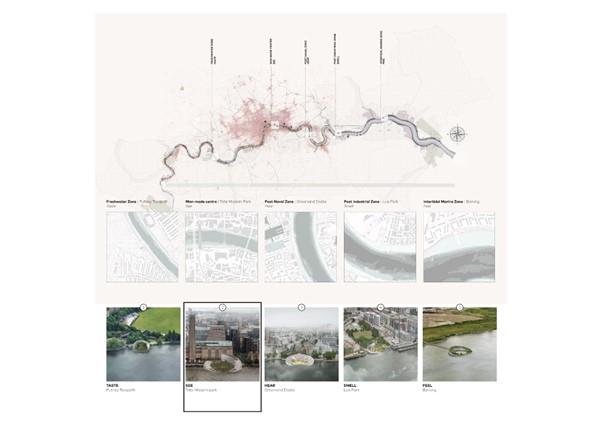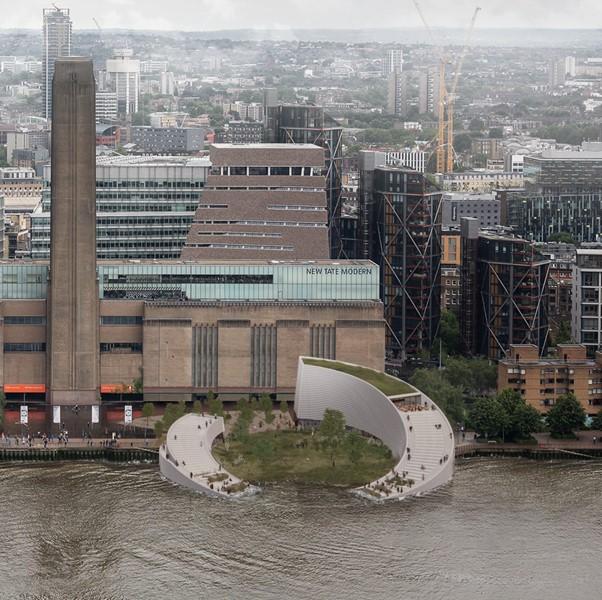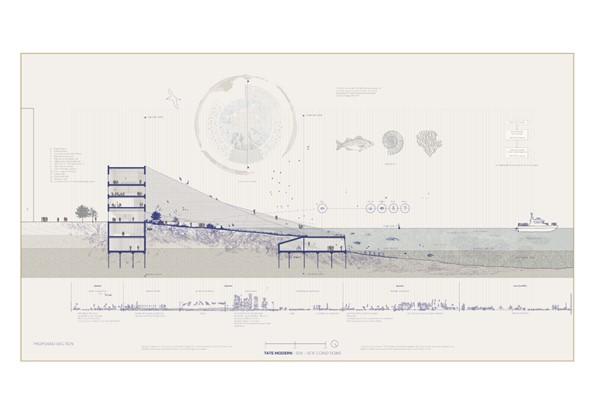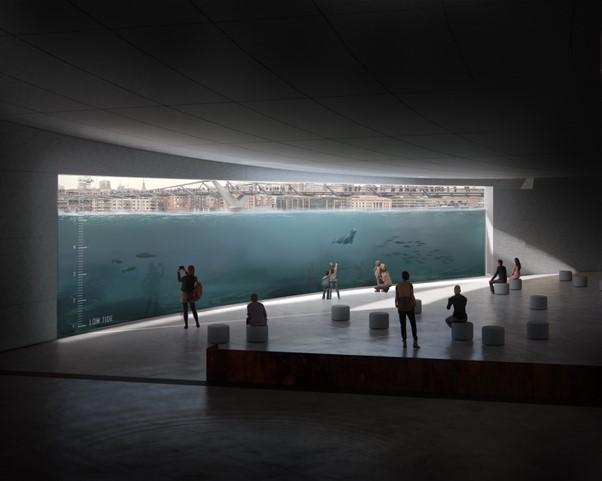Koen Stam

In this blog post, TU Delft alumni Koen Stam presents his graduation research, which aims to rethink the urban riparian condition through the use of architecture and towards a more symbiotic relationship between the urban river and the city. To do so, he researches the role of water, the waterfront and its fluid condition all influencing the functional totality of London with its emerging issues and contemporary challenges. This shines a new light on the role of the architect and how architecture could become a mediating actor between water and city and create an urgent need for a waterfront symbiosis. In this respect, it is fruitful to experiment with a new framework for developing an architectural typology that focuses on connecting humans and the non-human, while simultaneously regenerating the ecosystem.
The river Thames stands as the lifeblood of London, deeply interwoven with the city's past and present. Its significance in nurturing London's growth is undeniable. As the city developed throughout history, the river shaped not just the physical landscape, but also influenced London's socioeconomic structure, policies and cultural identity. However, this relationship between city and river is not one-sided. London's evolving needs and progress have, in turn, influenced the Thames' route and function. In the early stages, London regarded the river as an extension of its urban fabric rather than a boundary. The Thames played a multifaceted role, serving as a source of water and food, a means of transport, trade and communication. Its fluidity dictated the city's economic activities and guided urban expansion along its banks. Nonetheless, the onslaught of industrialization and globalization transformed the riverfront into a hub of industrial chaos. Factories, power stations and shipyards emerged, polluting and disregarding the river's ecosystem. This neglect led to the gradual relegation of the Thames from an integral part of city life to a mere border.
The relationship between the city and its river has arguably experienced a discord, symbolizing the struggle between nature's forces and human influence. Londoners' sentiments towards the Thames vary, illustrating complex and evolving connections. However, the impact of rapid urbanization and climate change has further strained the already delicate balance. Issues like flooding, environmental degradation and diminishing biodiversity are stark indicators of this continuing disconnect (Postel & Richter 2003). Prevailing engineering and planning strategies, centered on controlling the river, have led to unintended consequences. This includes the estrangement of the river from Londoners' daily lives, contributing to the deterioration of the river's functionality and the waterfront's significance. This 'broken' state necessitates immediate attention, in order to reconcile the lost harmony between the city and its river (Shannon 2008, ZSL 2021).
This urgent call for action demands a shift in perspective, particularly towards a more holistic and ecocentric approach that considers both human and non-human needs to envision a more resilient future. In the context of the Thames, this proposed paradigm seeks to bridge the gap between the city and the river, emphasizing re-engagement and a deeper connection rather than continuing the dominant approach of control and separation. Recognizing the importance of this integration is crucial to restore the Thames as an integral part of London's identity and urban fabric.
To engender a more symbiotic waterfront through architectural design, there arises a need for a re-evaluation of the role played by architects and architecture. The amalgamation of Marco Casagrande's 'Third Generation City' theory (2020) and Bruno Latour's 'Oligopticon' theory (2005) stands as a potent framework for shaping a new architectural typology. This typology concentrates on fostering a connection between human and non-human entities while concurrently rejuvenating the surrounding ecosystem. Casagrande's theory accentuates the integration of human activities within natural systems, advocating for a more comprehensive and symbiotic approach to urban design. It posits that architecture should not merely serve human needs but actively engage and respond to the natural environment (Casagrande 2020). Conversely, the 'Oligopticon' theory helps acknowledge the multifaceted nature of urban and river systems, recognizing diverse actors, layers and perspectives. This viewpoint encourages a collaborative approach involving a diversity of stakeholders, encompassing local communities, environmental experts and policymakers. In the London context, this inclusive and collaborative process can ensure a better understanding of the Thames river leading to more effective solutions in time. Within this conceptual framework, architecture operates as a space for exploring and reimagining our interaction with non-human elements. It seeks to rediscover the functionality, identity and significance of the river, through the lens of 'micro-narratives' (Latour 2005). This perspective allows for a nuanced understanding of the interplay between human activities and the natural environment, redefining the role of architecture in forging a more harmonious and sustainable relationship between the urban landscape and its surrounding ecosystem.
The process of engaging with the Thames river can be facilitated through the deliberate activation of human senses. This approach emerges as a logical consequence from the previously laid out theoretical framework, as it aims to establish a more profound connection between the inhabitants of London and the river. This deeper connection is envisioned to nurture a sense of responsibility and concern for the natural environment. Emphasizing the role of senses allows for a novel mode of observation that extends beyond a purely visual perspective. It revives the long-overlooked perspective of the Thames as an indispensable yet separated entity, gradually reintegrating it into the daily experiences of Londoners. In this context, specific sites have been strategically chosen in the design research as spaces primed for regeneration and potential socio-ecological integration. These selected sites have served as focal points throughout the research to establish and fortify the relationship between the river and the city, benefitting both ecology and society.
The established architectural design evolved towards a concept featuring a series of interconnected public observatories called River Rooms. These spaces are envisioned to facilitate the continuous monitoring and engagement with the river, while concurrently navigating various boundaries. These boundaries transcend the dichotomy between humans and non-humans, extending to encompass the intersections between form and fluidity, architecture and landscape, as well as program and regeneration. This paradigm not only fortifies the role of architecture as a mediator, but also assumes its responsibility of being an interdependent system. Given the evolving nature of this relationship over time, the resulting designs should also be considered to endure the passage of time itself. After all, the precise program and delineations between the urban landscape and the river remain subject to flux. Consequently, the architectural designs emerge as a pivotal and enduring protagonist in reinstating and sustaining the relationship between the waterway and the urban fabric.

Selected interventions at five designated sites each target individual human senses. The overarching concept draws inspiration from ripples, the result of stone-water interaction, forming an interconnected conceptual system on an urban scale. Ripples signify a strong connection between form, fluidity, the inhabitants of London and the river. Customized to fit local contexts and specific programs, the resulting River Rooms symbolize a city-water relationship that unifies the interventions across different sizes and shapes. A detailed approach was reserved for the 'SEE' River Room. Here, the general design concept was explored in more detail and in a specific spatial context, that of the Tate Modern museum.

The Tate Modern design intervention - SEE - safeguards the riparian zone while its shape mediates between the river and urban buildings. It incorporates dual entrances, functioning as both public riparian laboratories and an underwater observatory. The building's circulating pathways are curated to guide visitors closer to the Thames, with an underwater observatory, dynamic rooftop loop and riparian middle offering insights into the river's behavior during tidal shifts. It creates the ground for developing new relationships, inspired by the previously highlighted theoretical framework. Notably, the project emphasizes the importance of non-human elements, aiming to regenerate the Thames ecosystem through a symbiotic design approach that integrates considerations of shape, climate, materials and structural strategies.


Acknowledgement
This blog post is a synthesis of the 2023 Master thesis of TU Delft Architecture student Koen Stam, who was mentored by Agnes van der Meij and Johan van Lierop. This text was reviewed and edited by Vincent Baptist, in the context of discussions in the LDE PortCityFutures research community, reflecting evolving thoughts on the socio-economic, spatial and cultural questions surrounding port city relationships.
References
Casagrande, M. 2020. “From Urban Acupuncture to the Third Generation City.” In R. Roggema (ed.), Nature Driven Urbanism, 131-153. Springer.
Latour, B. 2005. Reassembling the Social: An Introduction to Actor-Network-Theory. Oxford University Press.
Postel, S., & Richter, B. 2003. Rivers for Life: Managing Water for People and Nature. Island Press.
Shannon, K. 2008. Water Urbanisms. SUN.
ZSL. 2021. The State of the Thames 2021: Environmental Trends of the Tidal Thames. ZSL. https://cms.zsl.org/sites/default/files/2022-10/ZSL_TheStateoftheThamesReport_Nov2021_0.pdf
